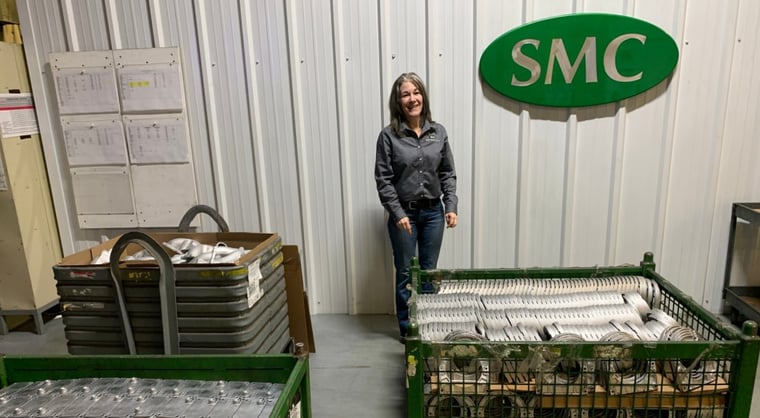What pops to mind when you think of CNC machining?
Metal. Castings. Precision. Engineering. Robots.
Not “inventory management,” huh? Well, perhaps it should. Because nothing gets done within a CNC machine shop without rock-solid warehouse inventory management.
In fact, if a shop doesn’t have exceptional inventory management, you should choose to work with a different supplier. Here’s why …
Meeting Customer Demand is Priority #1
Inventory management is managing the material in-house that’s required for CNC production jobs and coordinating that with customer orders. It’s having on-hand the right amounts of the right materials. In a CNC machine shop, that means castings and components (and lots of them). This diligent attention and industry knowledge is the only way to meet customer demand.
Smart Systems
Thousands of parts and components present a significant material requirement planning challenge. That’s tackled in high-end CNC machine shops by enterprise resource planning (ERP) software, coordinating with production requirement planning (PRP) software, which handles inventory of not just materials, but also human resources and equipment.
The steps, loaded with “alphabet soup” abbreviations, go like this:
- A customer loads an order, including all requirements, into an electronic data interchange (EDI) system that connects the two companies
- Jobs are entered into the ERP system
- Casting and component requirements are generated and entered into the PRP
- Those are typically entered into a materials requirements planning (MRP) system, where purchase orders are generated and released
ERP software does much more than help maintain a minimum inventory level. It presents company-wide visibility within a single system, driving CNC tool crib management, PRP scheduling and lead times, etc. all while providing extremely accurate data consolidation and reducing worry. Having visibility on materials at all times — raw material to finished goods — also allows customers to pull in orders, if the schedule allows.
Timing Is Everything
OK, it’s not everything, but it is incredibly important. In the world of CNC machining, there is no “best practice” as far as timing; it really depends on the shop (how it’s configured, operator skill level, equipment capabilities, customer demand, and so much more). Material inventory needs to be kept at the proper level for each particular shop.
“Just-in-time” production has never been more popular. While that is a reliable strategy for some manufacturers, other CNC machine shops think differently, letting customer requirements drive inventory. Proven calculations — used from casting to final quality assurance — include slight buffer zones, which allows for some rush projects to be completed on time.
No system is perfect, though, and when schedules need to be adjusted, the inventory manager works with production and customer service to ensure machines aren’t sitting idle and customer needs are prioritized.
A quick word on timing and purchasing power. Many small machine shops may have to take out a loan to purchase castings. Larger, more established CNC machine shops, however, may be able to use cash on hand to purchase castings in larger lot sizes; e.g., three month’s worth versus a smaller shop’s one. They can hold onto that stock, knowing the repeating work is coming all while getting a better price.
Additional business is often given to the larger shops because there’s confidence that they can handle the demand as well as any schedule shifts, even during uncertain times of a global pandemic.
How Material Inventory Affects Quality
Expanding on the example used above, if a CNC machine shop can purchase three month’s worth of castings at one time (300 instead of 100), it minimizes the foundry’s set-up time/cost and helps maintain consistency across the batch. Fewer miscellaneous issues arise when running a bigger batch size instead of three smaller ones.
If a run of castings does have a high fallout rate, the CNC machine shops’ quality scorecard should catch that immediately. Plus, the scorecard takes into account on-time delivery, the driver of inventory management, so quick feedback is always shared.
What else shows quality? A CNC machine shop that meets the standards for achieving various industry certifications. One example is International Automotive Task Force (IATF) certification. This organization monitors quality products in the automotive industry worldwide, and demands a quality standard even higher than ISO certification.
Inventory Management Success is Clear to See
From a customer’s point of view, there are three main goals of CNC machining — products that 1) meet or exceed quality standards, 2) are delivered when promised, and 3) sold at a competitive price. All three are impacted by a shop’s inventory management as well as a shop’s overall culture and “must have” people.
It takes exceptional inventory management to achieve exceptional product delivery, especially when thousands of castings are being machined each month. Stecker Machine’s inventory management system is proven successful by:
- Shorter lead times
- Castings and components arriving 14 days prior to machining
- Dozens of trusted foundry partnerships
- Scoring in the high 90 percentile with all major customers in all categories during quarterly and yearly reviews
Stecker’s advanced inventory management is the key to minimizing inventory and saving money, which is then passed down to customers. Want to learn more about machine shop efficiency? Read our eBook: The Benefits of Lean Manufacturing in Machine Shops.






